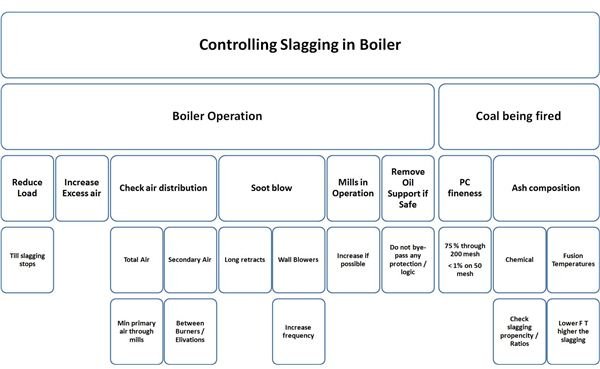How to Prevent Slagging in a Boiler Furnace
Slagging and deposition in coal fired boilers is a complex phenomenon. The reasons can be due to coal characteristics, operating conditions, the design of the boiler furnace, or can be a combination of any of the three with others or all. When heavy deposition or slagging starts in the boiler, the boiler operating group can contain the problem, to a large extent, by taking corrective action.
As the boiler has been designed and put in operation, the design shortcomings, if any, can be overcome by suitably changing the operating practice. In most cases this is seen to be successful. For example, when the boiler elevation heat loading is set at a higher value then operating, one more mill will increase the number of burners or the elevation depending upon the type of firing. There are two major areas where the boiler operator will have to concentrate: on the operating parameters of the boiler and on the coal being fired.
Operating parameters
- First check the excess air being given to the boiler for combustion. If it is lower than recommended by the designers, then increase it. It may even help if the excess air is increased slightly above the design recommendation.
- Check the primary air through the mill. If they are much higher than required, this reduces the secondary air available for combustion, since the excess air in the boiler is maintained.
- Once the primary air is ensured to be the minimum required, then check the secondary air distribution between the burners or elevation accordingly.
- Check if the number of mills in operation can be increased, if yes then cut in new mill and reduce the load on the operating mills. During this suitably take care of secondary air distribution.
- If for any reason a high reactive fuel like oil or gas is fired in combination with coal then it will be good to remove this fuel. High reactive fuel will reduce oxygen availability for coal molecules resulting in a localized reducing atmosphere. This increases the potential for coal ash to slag.
- Check the soot blower operation, both the wall blowers in the furnace and the long retract. Increase the frequency of wall blowers as this can cool the flame more and reduce the slagging potential.
- Check the pulverized coal fineness ensure 75% through 200 mesh sieve and only less than 1% is left over 50 mesh sieve.
- If with all the above the heavy deposition / slagging does not reduce then this may even warrant a load reduction on the boiler.
Coal being fired
The coal being fired can be outside the design range and could be causing the problem. This warrants checking the coal ash characteristic in detail.
- Check the chemical composition of the ash and work out the slagging propensity ratios. If it fits in a matrix of these ratios, then it can give an idea whether the coal being fired can slag in the boiler.
- Check the ash fusion temperatures starting from initial deformation temperature to fusion temperature. Normally this is carried out in an oxidizing condition; it will be a good practice to check the fusion temperature in the reducing atmosphere. A high differential between this will indicate a higher propensity to slag. In this case air distribution and excess air level play a high role.
Elaborate studies both in the field and laboratories by collecting large volume data on all required area has not yielded a single or multiple set of rules to predict coal slagging in boiler furnaces.
